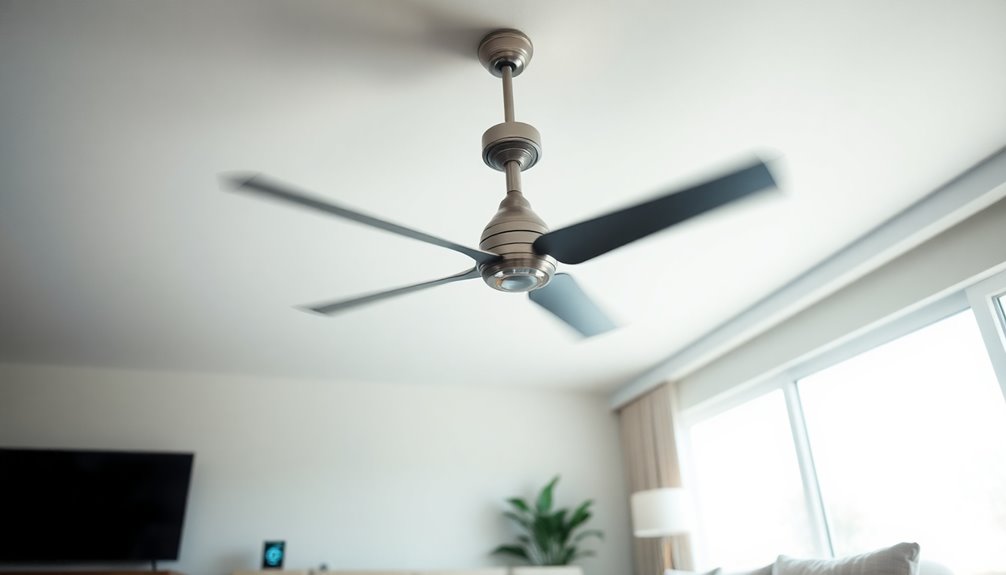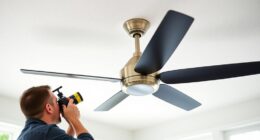Ceiling fans are actually quite efficient when it comes to electricity use. They typically consume between 50 to 90 watts per hour. For instance, a standard 48-inch fan uses around 75 watts. If you run it for about six hours, it'll only cost you around five cents! Compared to air conditioning units, ceiling fans can slash your electricity costs by up to 80%. By using them strategically, you can even set your thermostat higher in summer and save more energy. Interested in finding out more ways to maximize your comfort and savings? Keep exploring for additional tips and insights!
Key Takeaways
- Ceiling fans typically consume between 50 to 90 watts per hour, with a common 48-inch fan using around 75 watts.
- Operating a ceiling fan for 8 hours costs approximately $0.10, making it much cheaper than air conditioning.
- Ceiling fans can save homeowners about 80% on electricity bills compared to air conditioning units when used strategically.
- Energy-efficient ceiling fans can reduce consumption by up to 50%, making them even more economical.
- Regular maintenance and proper sizing improve fan efficiency, ensuring minimal electricity usage while maximizing comfort.
Ceiling Fan Energy Consumption

Understanding ceiling fan energy consumption can help you make smarter choices for your home. Ceiling fans generally consume between 50 to 90 watts per hour, which is considerably less than air conditioners that can use up to 3,500 watts.
For instance, a 48-inch ceiling fan runs on about 75 watts, costing you around $18.77 annually if you operate it for 8 hours a day. This low electricity usage makes ceiling fans an attractive alternative to traditional cooling devices.
Choosing ENERGY STAR® certified ceiling fans can further enhance your savings. These models are up to 60% more efficient than non-rated fans, leading to even lower power consumption over time.
If you opt for a smaller 36-inch fan, it only uses about 55 watts, while a larger 52-inch fan may consume up to 90 watts. In comparison, running a ceiling fan for just 6 hours a day could cost you roughly 5 cents daily.
This substantial difference in the cost of running makes ceiling fans a smart choice for keeping your space cool while consuming less energy and lowering your overall electricity bills.
Cost Analysis of Ceiling Fans

When evaluating the expenses associated with cooling your home, the cost analysis of ceiling fans reveals their significant advantages. Operating a ceiling fan uses much less electricity than air conditioners, leading to substantial savings.
Here are some key points to reflect on:
- A standard ceiling fan consumes between 50 to 90 watts per hour. This translates to an annual cost of about $18.25 when running for 6 hours daily.
- Operating a ceiling fan for 8 hours a day at 75 watts costs around $0.096 daily, which totals roughly $2.88 monthly.
- Compared to air conditioners, ceiling fans can save you about 80% on electricity bills since air conditioners consume at least 1,200 watts.
- Energy Star-rated ceiling fans are up to 60% more efficient than non-certified models, reducing your operational costs over time.
Comparing Fans to Other Appliances

When you compare ceiling fans to other appliances, their efficiency stands out.
A ceiling fan typically uses much less energy than air conditioning units and even some tower fans. This makes them a cost-effective choice for staying cool without breaking the bank. Additionally, many modern ceiling fans come with energy-efficient motors that further reduce electricity consumption. Regular home cleaning can also enhance airflow around the fan, improving its efficiency even more. Furthermore, using ceiling fans in conjunction with heat pump systems can significantly boost overall energy efficiency in your home. This is particularly beneficial since heat pumps can achieve efficiencies of 300-600%, making them an ideal pairing with ceiling fans for optimal comfort. Moreover, ensuring proper airflow around the unit can further enhance the performance of both the ceiling fan and any air purification devices used alongside it.
Ceiling Fan Efficiency
Ceiling fans stand out as one of the most energy-efficient cooling options available, especially when compared to other appliances like air conditioners. While a standard ceiling fan consumes only 50 to 90 watts of electricity, air conditioners can use anywhere from 500 to 3,500 watts, depending on the model. This stark difference illustrates how much more energy-efficient ceiling fans are.
Consider these points about ceiling fan efficiency:
- A typical 48-inch ceiling fan uses about 75 watts, costing approximately $18.25 per year if you operate it for 6 hours daily.
- In contrast, a window air conditioner might cost around $81.50 annually for the same usage, highlighting the cost-effectiveness of fans.
- Energy Star-rated ceiling fans are up to 60% more efficient than non-certified models, providing significant energy savings.
- The electricity consumption of ceiling fans is comparable to that of a phone charger, showing their low energy usage in relation to other cooling appliances. Additionally, many models come with smart technology, allowing for more convenient control and efficiency. In commercial settings, integrating ceiling fans with energy-efficient heat pumps can optimize climate control and further reduce energy costs.
- Additionally, using ceiling fans in conjunction with heat pumps can enhance overall energy efficiency and reduce cooling costs even further.
Appliance Energy Comparison
Comparing energy consumption among household appliances reveals just how efficient ceiling fans really are. A typical ceiling fan uses only 50 to 90 watts per hour, while running an air conditioner can demand between 500 to 3,500 watts. This stark difference means ceiling fans use considerably less electricity, which can lead to lower electricity bills. Additionally, the technology used in modern fans has improved, making them even more energy-efficient than older models. Furthermore, using ceiling fans in conjunction with heat pumps can enhance overall energy savings by reducing the reliance on air conditioning.
For instance, operating a standard 48-inch ceiling fan for six hours costs you about $0.054 daily, compared to an air conditioner's $1.20 for the same period. Additionally, using ceiling fans can contribute to improved air quality by circulating air effectively, which is beneficial for overall health. A well-maintained ceiling fan can also help optimize ventilation in your living space.
When you look at various fan types, even box fans consume more energy, ranging from 60 to 110 watts, and can rack up annual costs between $30 to $54.
High-efficiency ceiling fans, especially those rated by ENERGY STAR®, are up to 60% more efficient than their non-certified counterparts. This efficiency translates to annual operating costs of just $18.25 to $20 for a typical ceiling fan, while efficient air conditioning systems can exceed $81.50 per year. Additionally, using ceiling fans can enhance airflow and further reduce the need for air conditioning.
Clearly, if you want to cut down on energy consumption and save on costs, investing in ceiling fans is a smart move.
Cost-Effective Cooling Solutions
A cost-effective cooling solution can make a notable difference in your energy bills, and ceiling fans stand out among household appliances.
Ceiling fans consume only 50 to 90 watts per hour, compared to an air conditioner, which can use between 500 to 3,500 watts. This stark difference makes fans an energy-efficient option for keeping you cool.
Here are four reasons to evaluate ceiling fans:
- Lower Energy Costs: Running a ceiling fan for 8 hours costs about $0.10, while an air conditioner could cost around $1.20.
- Energy Efficient Models: High-efficiency ceiling fans, like ENERGY STAR® certified ones, can save you even more on your electric bill—up to 60% more efficient!
- Reduced AC Usage: By strategically using ceiling fans with higher thermostat settings, you can cut down your air conditioning usage by up to 20%.
- Annual Savings: A 48-inch ceiling fan can cost just $18.25 annually, noticeably less than a standard box fan's $30.
Seasonal Fan Direction Tips

To maximize comfort and energy efficiency, you should adjust your ceiling fan's direction with the seasons.
In summer, set it to rotate counterclockwise for a revitalizing breeze, while in winter, switch it to clockwise to circulate warm air.
Making these simple adjustments can notably lower your heating and cooling costs throughout the year.
Summer Counterclockwise Rotation
During the sweltering summer months, adjusting your ceiling fan to rotate counterclockwise is essential for creating a revitalizing breeze in your home. This simple adjustment enhances airflow, producing a cooling breeze that can lower your perceived temperature by up to 4°F without changing the actual room temperature.
Here's why you should take advantage of counterclockwise rotation this summer:
- Increased Airflow: The fan's blades push air down, maximizing airflow and enhancing the wind chill effect.
- Reduced Reliance on Air Conditioning: By creating a cooling breeze, you might need to lower your air conditioning usage, saving on energy costs. Statistics show that efficient cooling methods can lead to significant energy savings during peak consumption times.
- Energy Efficiency: Correctly using your ceiling fans allows you to set your thermostat higher while remaining comfortable.
- Easy Adjustment: Most ceiling fans come with a switch or pull cord to easily reverse blade direction for seasonal changes.
- Additionally, using ceiling fans effectively can contribute to reducing energy consumption across your home by complementing your heating and cooling systems.
Winter Clockwise Rotation
As the temperatures drop and winter sets in, switching your ceiling fan to rotate clockwise becomes important for maximizing comfort in your home. This simple adjustment helps circulate warm air that rises to the ceiling, pushing it downward to maintain a cozy atmosphere.
When you correctly adjust your fan's direction, you can reduce heating costs considerably. By setting your thermostat 4°F higher without sacrificing comfort, you'll notice a difference in your energy bills. Plus, ceiling fans are energy-efficient, typically consuming between 55 to 90 watts, which allows you to heat your space while consuming less energy overall.
Here's a quick overview:
| Ceiling Fan Benefits | Details |
|---|---|
| Direction | Rotate clockwise |
| Energy Consumption | 55 to 90 watts |
| Heating Cost Reduction | Set thermostat 4°F higher |
Efficient Direction Adjustment
Adjusting your ceiling fan's direction can make a significant difference in your comfort and energy efficiency throughout the year.
By knowing when and how to change the rotation, you can maximize the cooling effect in summer and minimize heating costs in winter.
Here are some tips for efficient direction adjustment:
- Summer: Set your ceiling fan to rotate counterclockwise. This creates a cool breeze, allowing you to raise your thermostat by up to 4°F without sacrificing comfort.
- Winter: Reverse the fan to rotate clockwise. This helps circulate warm air that rises to the ceiling, making your space feel warmer and reducing heating costs.
- Switching Directions: Most fan models have a switch or pull cord for easy adjusting direction. Familiarize yourself with this feature to optimize airflow.
- Energy Savings: Proper airflow from your ceiling fan can lead to better energy efficiency, ultimately lowering your electricity bills. Additionally, keeping your fan well-maintained can prevent mechanical failure and ensure it operates efficiently.
Energy Efficiency Strategies

How can you maximize the energy efficiency of your ceiling fans? Start by investing in Energy Star-rated ceiling fans, which can improve energy efficiency by up to 60% compared to non-rated models. This can lead to markedly lower electricity bills over time.
By using these energy-efficient fans, you can also reduce air conditioning costs. Raising your thermostat settings by about 4°F while running your ceiling fan keeps you comfortable and saves energy.
Regular maintenance is vital too. Cleaning your ceiling fan and ensuring proper blade alignment enhances performance and maintains energy efficiency. Make it a habit to check your fan regularly to keep it running smoothly.
Additionally, think about the strategic use of your ceiling fans. Turn them off when rooms are unoccupied to decrease electricity usage even further. This simple action won't only contribute to your energy conservation efforts but also help you get the most out of your ceiling fan.
Consider pairing your ceiling fan usage with the top-rated vacuums for a comprehensive approach to home energy efficiency.
Choosing the Right Fan Size

Choosing the Right Fan Size
Selecting the right ceiling fan size is essential for achieving ideal airflow and energy efficiency in your space. An appropriately sized fan can help you manage energy consumption and reduce electricity costs effectively.
Here are some key considerations when choosing the fan size:
- Room Size: Measure your room's square footage. A 44-inch ceiling fan works well for areas up to 225 square feet, while a 52-inch fan is suitable for spaces up to 400 square feet. Additionally, the best air flow ceiling fans can enhance comfort by providing efficient circulation.
- Power Consumption: Keep in mind that larger fans typically consume more electricity. A 52-inch fan may use about 90 watts, while a smaller 36-inch fan consumes around 55 watts per hour. Moreover, geothermal heat pumps can further reduce energy costs in your home by optimizing overall energy use.
- Optimal Airflow: Fans that are too large for a small room can cause discomfort and lead to unnecessary energy usage.
- Energy Management: Properly sizing your ceiling fan can enhance cooling efficiency and potentially reduce electricity usage by up to 20%. Additionally, utilizing energy-efficient appliances can further contribute to lowering your overall energy consumption.
Benefits of Using Ceiling Fans

Using ceiling fans offers numerous benefits that can markedly enhance your comfort while saving on energy costs. Unlike air conditioning units that can consume up to 3,500 watts, ceiling fans typically use between 50 to 90 watts per hour, meaning they draw much less electricity. This significant reduction can lead to annual energy savings of around $18.25 when you run a fan for just six hours daily.
One of the key advantages of ceiling fans is their ability to create a wind chill effect. This allows you to increase your thermostat settings by 4°F without sacrificing comfort, further cutting down on energy consumption. If you opt for ENERGY STAR® certified ceiling fans, you can enjoy even more efficiency—up to 60% better than non-rated models. Additionally, wood smoke from traditional heating methods can contribute to air pollution, making ceiling fans a cleaner alternative for maintaining comfort. Properly installed and maintained wood pellet stoves can also offer efficient heating solutions, enhancing your overall energy strategy. Moreover, implementing RMD strategies can help you manage and allocate funds effectively for energy-efficient improvements. Maintaining a proper budget for energy-efficient appliances can help you prioritize investments that yield long-term savings.
Proper seasonal operation is essential, too. Running your fan counterclockwise in the summer enhances cooling by circulating air, while clockwise in the winter helps distribute warm air. Additionally, incorporating budgeting for energy efficiency into your overall financial planning can maximize your savings on utility bills.
Frequently Asked Questions
How Much Does It Cost to Run a Ceiling Fan 24 Hours a Day?
If you run a standard ceiling fan for 24 hours a day, it'll cost you about $2.68 a month, based on an electricity rate of $0.169 per kWh.
This amounts to roughly $32.76 annually.
If you choose an Energy Star-rated model, your costs could drop to around $1.53 monthly.
Can Ceiling Fans Cause a High Electric Bill?
Imagine a warm summer day, the gentle breeze from your ceiling fan wrapping around you like a comforting hug.
You might wonder if that soothing airflow could lead to a hefty electric bill. The truth is, while ceiling fans do use electricity, they're much more efficient than air conditioners.
If you remember to turn them off when you leave a room, you'll keep your costs down and enjoy that invigorating breeze without the worry.
Does Leaving a Ceiling Fan on Use a Lot of Electricity?
Leaving a ceiling fan on doesn't use a lot of electricity, but it can be wasteful if no one's in the room.
Fans create a wind chill effect, cooling you down but not lowering the room temperature.
So, if you forget to turn it off when leaving, you're spending money for no reason.
To save energy, switch it off when you're not around, and enjoy those savings on your electricity bill!
Is It Cheaper to Run Ceiling Fans or Air?
If you're deciding whether to run ceiling fans or air conditioning, you'll find ceiling fans are the cheaper option.
They consume much less electricity—typically between 50 to 90 watts—compared to air conditioners that can use up to 3,500 watts.
Running a ceiling fan for eight hours costs about $0.096, considerably less than the $1.20 for an air conditioner.
Plus, ceiling fans can help you raise your thermostat setting without sacrificing comfort.
Conclusion
To sum up, ceiling fans aren't just a breeze of comfort; they're a smart choice for your energy bill. By using them wisely, you'll not only save money but also enjoy a invigorating airflow that transforms your space into a cool oasis. So, why not embrace the gentle whir of your ceiling fan? With the right strategies, you'll create a cozy atmosphere without breaking the bank, making your home both inviting and energy-efficient.









